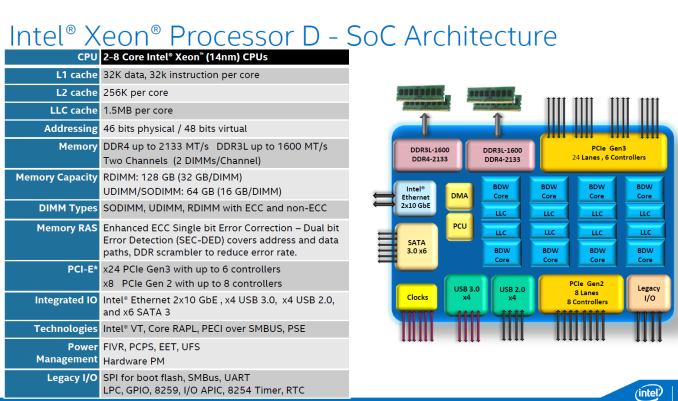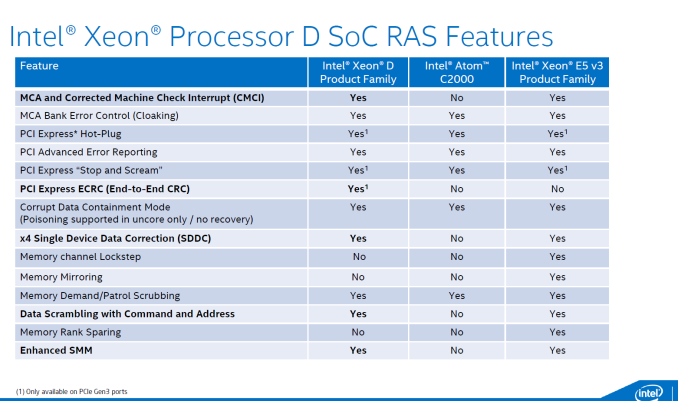The Intel Xeon D Review: Performance Per Watt Server SoC Champion?
by Johan De Gelas on June 23, 2015 8:35 AM EST- Posted in
- CPUs
- Intel
- Xeon-D
- Broadwell-DE
Broadwell in a Server SoC
In a nutshell, the Xeon D-1540 is two silicon dies in one highly integrated package. Eight 14 nm Broadwell cores, a shared L3-cache, a dual 10 gigabit MAC, a PCIe 3.0 root with 24 lanes find a home in the integrated SoC whereas in the same package we find four USB 3.0, four USB 2.0, six SATA3 controllers and a PCIe 2.0 root integrated in a PCH chip.
The Broadwell architecture brings small microarchitectural improvements - Intel currently claims about 5.5% higher IPC in integer processing. Other improvements include slightly lower VM exit/enter latencies, something that Intel has been improving with almost every recent generation (excluding Sandy Bridge).
Of course, if you are in the server business, you care little about all the small IPC improvements. Let us focus on the large relevant improvements. The big improvements over the Xeon E3-1200 v3 are:
- Twice as many cores and threads (8/16 vs 4/8)
- 32 GB instead of 8 GB per DIMM supported and support for DDR4-2133
- Maximum memory capacity has quadrupled (128 GB vs 32 GB)
- 24 PCIe 3.0 lanes instead of 16 PCIe 3.0 lanes
- 12 MB L3 rather than 8 MB L3
- No separate C22x chipset necessary for SATA / USB
- Dual 10 Gbit Ethernet integrated ...
And last but not least, RAS (Reliability, Availability and Servicability) features which are more similar to the Xeon E5:
The only RAS features missing in the Xeon D are the expensive ones like memory mirroring. Those RAS features a very rarely used, and The Xeon D can not offer them as it does not have a second memory controller.
Compared to the Atom C2000, the biggest improvement is the fact that the Broadwell core is vastly more advanced than the Silvermont core. That is not all:
- Atom C2000 had no L3-cache, and are thus a lot slower in situation where the cores have to sync a lot (databases)
- No support for USB 3 (Xeon D: four USB 3 controllers)
- As far as we know Atom C2000 server boards were limited to two 1 Gbit PHYs (unless you add a separate 10 GBe controller)
- No support for PCIe 3.0, "only" 16 PCIe Gen2 lanes.
There are more subtle differences of course such as using a crossbar rather than a ring, but those are beyond the scope of this review.













90 Comments
View All Comments
julianb - Saturday, October 31, 2015 - link
Thanks for the reply, man.And sorry for my late reply, totally forgot about this thread :)
eva2000 - Tuesday, June 23, 2015 - link
Nice... Xeon D-1540 is awesome, but I wish it was clocked 0.2Ghz higher across the board would be just enough to tip that scale versus E5. Did my own benchmarks at https://community.centminmod.com/threads/2864/ :)extide - Wednesday, June 24, 2015 - link
Thats probably exactly why it ISNT clocked 0.2Ghz higher across the board ;)I'm sure Intel wants to see some space between this and E5.
boogerlad - Tuesday, June 23, 2015 - link
If this was marketed for the consumer market with the ability to overclock, this would outsell everything completely. This is what the enthusiast needs!!!Refuge - Tuesday, June 23, 2015 - link
I don't think this is going to do much of anything for an enthusiast.Unless they are interested in building a server for some experiment or project.
JohanAnandtech - Wednesday, June 24, 2015 - link
I still think the i7 59xx series is a better match for consumers: higher clocks and thus ST performance. The Xeon D most interesting features such as integrated 10 GBe and low power don't interest most performance consumers. Most people will have a hard time saturating a 1 GBe line and power savings are not a priority.tspacie - Wednesday, June 24, 2015 - link
Seems to tick all the boxes for a software development machine. Very good at compilation. Reasonably priced for the performance. Low power. ECC memory. I'm temptedextide - Wednesday, June 24, 2015 - link
EXACTLY what I was thinking!MrSpadge - Saturday, June 27, 2015 - link
I would be very tempted by such a chip as well, using it for BOINC. However, Broadwell looses some of the power efficiency advantage if you push it harder, i.e. the largest gains are at low and moderate frequency. Perfect for such server chips and mobile ones, but not so much for people aiming for 4+ GHz.MaxKreimerman - Tuesday, June 23, 2015 - link
Sounds impresive in just 45w package, but imposible to find in the retail sites such as newegg or wiredzone